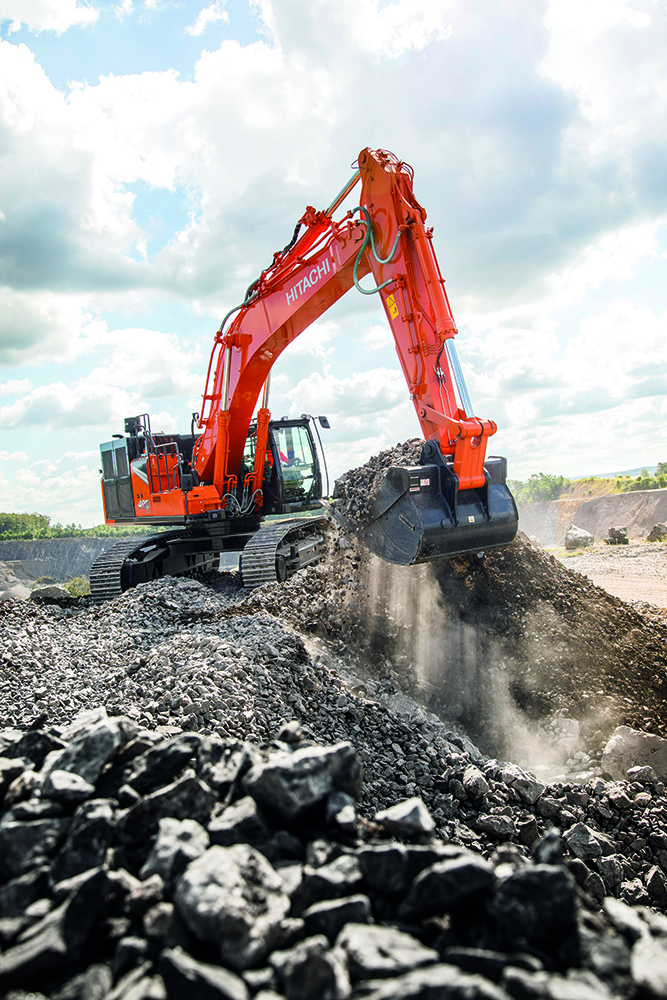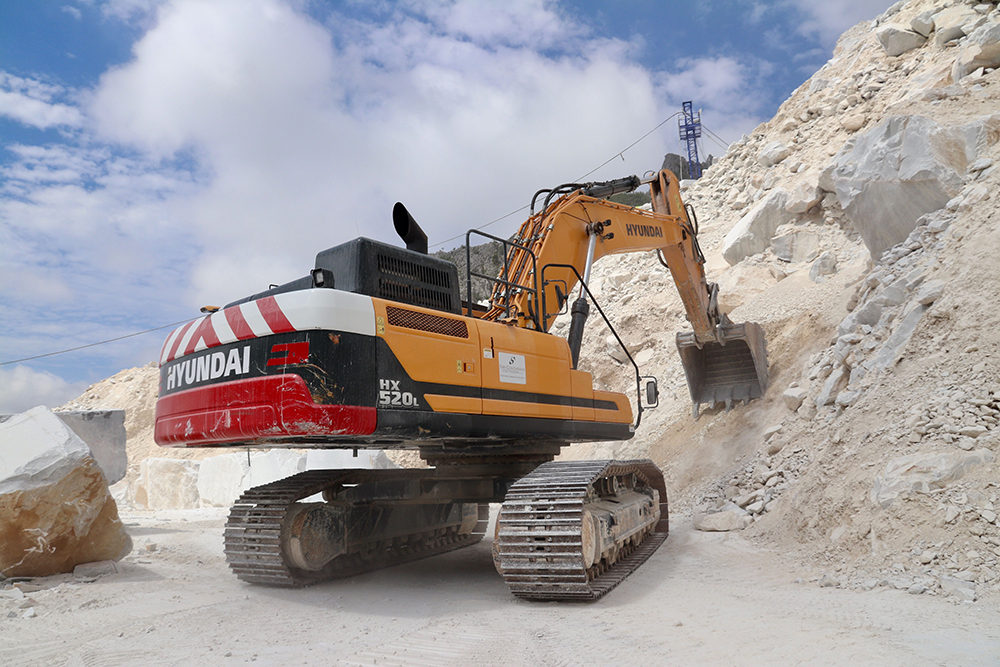
The Italian government has ended restrictions on 130 construction projects considered strategic for relaunching Italy’s post-COVID-19 economy and for modernising the nation’s infrastructure network.
The relaunched projects, worth a combined €200 billion, are part of Italy’s version of the Build Back Better masterplan, much trumpeted in countries like the US, UK, and China. They also form part of a new Simplification Decree, which includes a series of measures to reduce bureaucracy and modernise and stimulate production. The projects will benefit from a quicker approval process aimed at guaranteeing a speedy reopening of construction sites and on-time completion. The rapid build of the new Genoa Bridge, which opened in August 2020, is an example of how this approach can be highly effective and safe.
Renewed widescale Italian infrastructure building will significantly increase Italian mineral products demand. Nico Nasini, sales officer manager at SCAI, Hitachi Construction Machinery (Europe’s), authorised dealers in Italy, summarises the improved market conditions.

“After years of decline, the quarrying market is enjoying a period of recovery. This is due to some new state incentives that have seen the recommencement of infrastructure projects, such as public and road construction works. In turn, this has led to an increase in demand for the supply of aggregates. These projects will not only relaunch the economy but also modernise the country’s infrastructure network.
“There are so-called ‘great works’ that have been financed and approved by the state. These include high-speed railway links, numerous major road networks and waterworks for protection against high water.”
Nasini says quarrying customers are looking for reliability and low fuel consumption from their loading machines. “Hitachi Construction Machinery is renowned for the former, and enhanced hydraulic systems, like those of the new Zaxis-7 excavators, contribute successfully to the latter. Our customers also benefit from the professionalism of our technical assistance and the immediate availability of genuine spare parts to avoid any unnecessary downtime.”
The ZX530, 690 and 890LCH-7 large excavator models are said by Nasini to be in high demand among Italian quarry customers. “They are known for their reliability, strength and durability to cope with heavy-duty operations in the challenging environments of the quarrying sector. Furthermore, the LCR models are built with reinforced parts and are ideal for digging and loading heavy materials. And the ZW310-6 wheeled loader is also popular due to its reliability and strength for loading trucks in quarries.”
GlobalData’s April 2021 published report Construction in Italy – Key Trends and Opportunities to 2025 tips the Italian construction industry to rebound in 2021, growing 5.3% in real terms following a decline of 6.3% in the previous year. “Italy was the first European country to impose a lockdown last year in response to the pandemic. Although the construction industry was temporarily closed last year, operations resumed in May 2020, after almost two months of shutdown,” notes the report by the major global business market intelligence consultancy.
GlobalData warns that a risk to the industry’s positive outlook arises from any upsurge in COVID-19 infections and subsequent tightening of lockdown restrictions in the country.
The report continues: “The rising national debt also poses a threat to government spending in the industry. Even before the outbreak of the pandemic, Italy was the second-most indebted country in the Eurozone. The outbreak of the pandemic, coupled with economic slowdown and the drastic increase in public spending on stimulus packages, has led to the country’s debt-to-GDP ratio rising from 134.6% in 2019 to 155.6% last year. The government is expected to receive a substantial windfall from the EU’s recovery fund, which will support the government’s plans to increase spending in infrastructure.”
Over the remaining part of GlobalData’s forecast period, the Italian construction industry is expected to register annual average growth of 1.6% between 2022-2025, supported by investment in housing, healthcare, transport, energy, and tourism infrastructure projects. The government’s focus on reducing carbon emissions in the country and supporting the renovation of buildings to make them more energy efficient will, says GlobalData, also support industry growth over the forecast period.
In June 2021, Veronafiere decided to postpone the debut of SaMoTer Demo Days - Outdoor Edition, the live quarry-based event in Vaprio d’Adda, near Milan, Italy, scheduled to take place 30 September-2 October 2021.
The decision was made due to factors linked to what organisers say is an “unforeseen and still rapidly evolving situation” related to the impact of the COVID-19 pandemic.
Veronafiere says that following the “sprint start” in the first quarter of 2021, which saw 3,783 Italian construction equipment units sold, a year-on-year rise of 40%, machinery builders globally are now finding it difficult to cope with new orders. This is due to the increased costs of raw materials, difficulties in finding mechanical components and delays in shipments.
“We are seeing significant growth in the market,” said Mirco Risi, president of Unacea, the Italian construction equipment association, “but in a very complex context characterised by changeable and uncertain dynamics. Under these circumstances, we take a positive view of Veronafiere’s approach in not forcing the market and proceeding in close harmony with the sector.”
“We note with regret that the variable background conditions make it impossible to hold an event which we had immediately supported,” said Claudio Bassanetti, president of ANEPLA (Associazione Nazionale Estrattori Produttori Lapidei Affinia), the Italian aggregates federation. “However, we are always more than willing to collaborate again in the future with Veronafiere.”
“An unforeseeable scenario obliged the construction machinery sector to implement a sudden change of direction,” said Giovanni Mantovani, CEO of Veronafiere. “This is why we considered postponing Demo Days. Organising trade fairs tailored to the needs of partners requires flexibility and rapid adaptation in order always to provide the best business and promotion tools on the market. We will now work with even more effort on the next edition of SaMoTer by recalibrating a new approach during the run-up to the exhibition.”
In March 2023, Veronafiere will host the 31st edition of SaMoTer, the most important exhibition in Italy dedicated to construction equipment.

Italy is one of the bigger aggregates-producing nations in Europe, according to UEPG (European Aggregates Association) production estimates data. The country’s 1,120 aggregates producers work across 2,800 extraction sites, producing an estimated 164 million tonnes in 2018. That made Italy the seventh-largest aggregates-producing country in Europe that year, more than Spain’s 124 million tonnes, but considerably less than the top four: Russia (736mn tonnes), Germany (597mn tonnes), Turkey (430mn tonnes), and France (429mn tonnes).
Encouraged by its experience gained over the past years and driven by the ever-growing demand to organise live training and exhibition events, ANEPLA is staging CavaExpoTech 2021 on Wednesday 22 September 2021.
The event’s special guest is Cave Merlini who will host event attendees at the company’s Cava Boscaccio site in Gaggiano, Milan. An ANEPLA spokesperson said the association was very proud to be staging its new event with the support of a flagship Italian quarrying company. The spokesperson said the “foresight, entrepreneurial spirit and environmental sensitivity” that the Merlini family showcases in its business practices had resulted in Cave Merlini winning several national and international awards.
CavaExpoTech 2021 is open to all its extractive industries and earthmoving company members who can also exhibit on the day. The day’s programme includes a morning presentation on the latest developments on the circular economy and renewable energy, a highly topical issue for the entire supply chain that unites both the extractive companies and their suppliers of capital goods and services. This will be followed by a tour of exhibiting companies’ stands. The event’s afternoon session will include field testing of earthmoving machines and innovative plant technologies.
It would be no surprise if the Italian government’s refreshed commitment to huge construction projects is a further topic of eager conversation during CavaExpoTech 2021, and at other ANEPLA events during the remainder of this year and in the first half of 2022.








